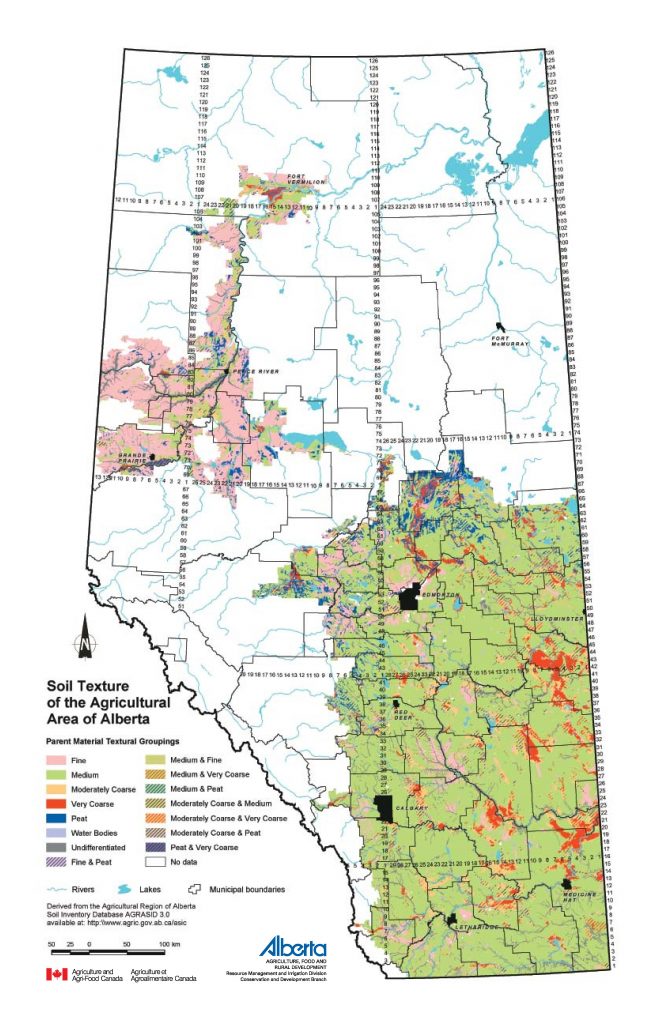Agriculture in Alberta

Alberta has one of the world’s most productive agricultural economies. In 2020, Alberta farms reported $22.2 billion in revenue which was more than any other province and represented over 25% of Canada’s total farm revenue [i]. There are over 41,500 farms in Alberta which, in 2021, was almost 22% of Canada’s farms. This represented 49.2 million acres, second only to Saskatchewan, and representing 32% of Canada’s total farm land.
The diversity of landscapes within Alberta allows for the wide variety of its products. The agricultural sector is diverse, including both crop and livestock production, among many other products. Farming and ranching helped build the economy and attracted early immigrants to Alberta.
Farming renewable energy
A newer “crop” is solar energy production. In 2021, 8.7% of Alberta farms reported producing solar energy – 1% above the Canadian measure. In terms of producing renewable energy more broadly, Alberta farms were slightly below (10.2%) the Canadian measure (11.9%).
Crops in Alberta
In 2022, “agriculture, forestry, fishing and hunting” accounted for around 2.8% of Alberta’s GDP [ii]. In 2022, wheat remained the largest crop, with production estimated at around 416.8 million bushels (~11.3 million tonnes), followed by barley (247.13 M bushels) and canola (246.55 M bushels) [iii]. Wheat, barley and canola together accounted for over three fourths of the total crop production. The province’s annual crop production (2014 to 2022) is shown in the diagram below.

To view the spatial distribution of various crops across Canada, see these US Department of Agriculture Foreign Agricultural Service maps [iv].
Livestock in Alberta
Alberta is a major livestock producer in Canada, with a large and diverse industry including beef cattle, dairy cattle, hogs, poultry, sheep, goats, bison, elk and horses. The July 2023 live-stock estimates [v] note that Alberta held the largest cattle count (43.2% of Canada’s total) followed by Saskatchewan (20.5%) and Ontario (13.2%). This represented a 1.5% year-on-year decline for Canada.
In terms of revenue, Alberta’s livestock industry generated the majority of the provincial agricultural revenue. Over the 2018-2022 period, cattle and calves alone generated an average annual $5.5 billion compared to $3.1 billion for canola and $2.5 billion for wheat [vi]. In 2022, total Alberta livestock farm cash receipts were reported as $8.9 billion, some 40% of Alberta’s total farm cash receipts and some 27% of Canada’s total farm cash receipts for livestock [vii].
For more on agriculture see Agriculture & Irrigation in Alberta
Sources:
[i] Statistics Canada, 2023, Canadian Agriculture at a Glance: Alberta has the highest farm operating revenues in Canada. https://www150.statcan.gc.ca/n1/pub/96-325-x/2021001/article/00009-eng.htm. Accessed 2023-08-02.
[ii] Government of Alberta, 2023, Gross Domestic Product. https://economicdashboard.alberta.ca/topics/gdp/. Accessed 2023-08-02.
[iii] Government of Alberta, 2023, Wheat Production. https://economicdashboard.alberta.ca/dashboard/wheat-production#. Accessed 2023-08-02.
[iv] US Department of Agriculture Foreign Agricultural Service, 2018, Canada Crop Production Maps. https://ipad.fas.usda.gov/rssiws/al/can_cropprod.aspx. Accessed 2023-08-02.
[v] Statistics Canada, 2023, Livestock estimates, July 1, 2023. https://www150.statcan.gc.ca/n1/daily-quotidien/230823/dq230823d-eng.htm?indid=3212-1&indgeo=0. Accessed 2023-09-11.
[vi] Agriculture and Agri-Food Canada, 2023, Overview of Canada’s agriculture and agri-food sector. https://agriculture.canada.ca/en/sector/overview. Accessed 2023-09-11.
[vii] Statistics Canada, 2023, Farm cash receipts, annual (x 1,000) (Table 32-10-0045-01). https://www150.statcan.gc.ca/t1/tbl1/en/tv.action?pid=3210004501 or https://doi.org/10.25318/3210004501-eng. Accessed 2023-09-11.
